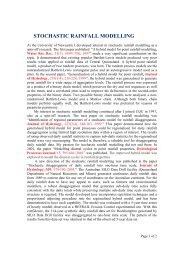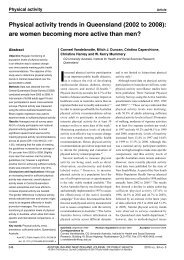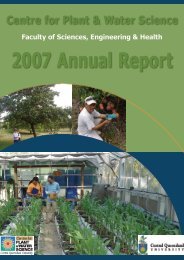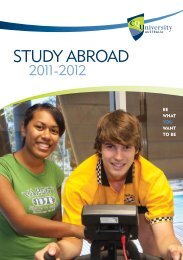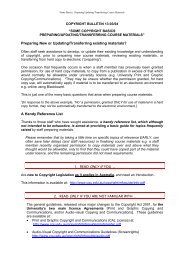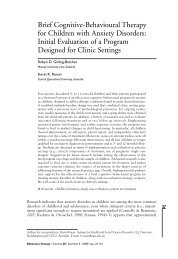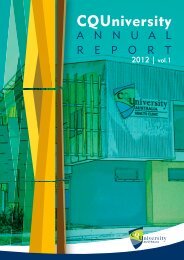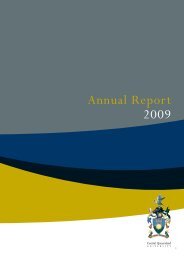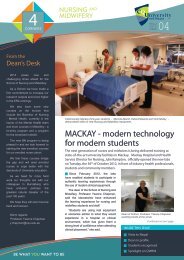Centre for Plant & Water Science - Central Queensland University
Centre for Plant & Water Science - Central Queensland University
Centre for Plant & Water Science - Central Queensland University
Create successful ePaper yourself
Turn your PDF publications into a flip-book with our unique Google optimized e-Paper software.
<strong>Centre</strong> <strong>for</strong> <strong>Plant</strong> & <strong>Water</strong> <strong>Science</strong> 2008 Annual Report<br />
AUTOECOLOGICAL ROLE OF STEVIOL GLYCOSIDES IN Stevia<br />
rebaudiana<br />
SUMMARY<br />
The physiological role of steviol glycosides (SG) in S. rebaudiana was explored by<br />
monitoring change in SG content in response to environmental conditions. Roles explored<br />
are carbohydrate reserve and osmoregulator. SG leaf content was determined through<br />
HPLC analysis of leaf extracts. Future investigation will test SG as an insect-deterrent<br />
compound. Near Infrared (NIR) spectroscopy will also be explored <strong>for</strong> non-invasive analysis<br />
of SG in stevia leaves.<br />
SG as an energy reserve<br />
Changes in SG leaf in response to relative to light and CO 2 were monitored to test the<br />
hypothesis that SGs function as an energy store in S. rebaudiana. Thirty plants were evenly<br />
distributed to different photosynthetic conditions (control 14 h light/10 h dark cycle,<br />
constant light, or constant dark). Two sets of five plants were maintained at either 500 or<br />
1400 ppm CO 2 under a 14 h light/10 h dark cycle. <strong>Plant</strong>s in both experiments were initially<br />
acclimatized in a single growth cabinet at 25 o C and 65% relative humidity <strong>for</strong> one week<br />
prior to treatment. Starch leaf content was observed to increase with increasing light<br />
exposure whereas SG leaf content remained constant. The same behaviour was observed in<br />
the CO 2 experiment wherein plants at 1400 ppm CO 2 had an overall (5%) increase in starch<br />
leaf content over 4 days while SG content remained constant. Results from both experiments<br />
indicate that SG is not used as an energy store.<br />
Control<br />
Light<br />
Dark<br />
[Left Figure.] Starch leaf content of control, constant light and constant dark group in the light experiment<br />
[Right Figure.] % leaf DW of stevioside and rebaudioside A of control, constant light and constant dark group in the<br />
light experiment<br />
SG as an osmoregulator<br />
Changes in SG leaf content were monitored under water stress conditions to test the<br />
hypothesis that SGs can function as osmoregulatory compounds. Fifteen plants were evenly<br />
distributed into three groups with the control group receiving 500 mL of water daily, the<br />
mild water stress group receiving 150 mL of water daily and the severe water stress group<br />
remaining unwatered until the end of the treatment period. Leaf osmotic potential was found<br />
to increase with increasing water stress whereas SG leaf content remained constant<br />
indicating that SG is not used as a leaf osmoregulator in S. rebaudiana.<br />
PROJECT STAFF Principal Investigator:<br />
Co-Principal Investigator:<br />
Ria Reyes / Kerry Walsh<br />
David Midmore<br />
FUNDING International Postgraduate Research Scholarship (IPRS)<br />
INCOME $2,000<br />
34





